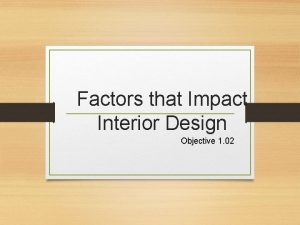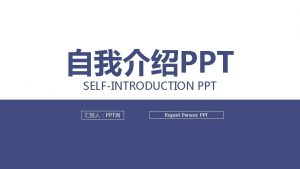Factors that Impact Interior Design Note This PPT










- Slides: 10

Factors that Impact Interior Design Note: This PPT does not contain images, please insert your own or download the Factors that Impact Interior Design PPT from the FI 51 Teacher Shared Resources Folder on Moodle.

Factors that impact interior design: 1. Human-Centered Factors 2. Social Factors 3. Global Impact Factors 4. Environmental Factors

Human-Centered Factors: Maslow’s Hierarchy of Needs: • Physiological (physical) • Safety and security • Love and belonging • Esteem • Self-Actualization

Human-Centered Factors: Anthropometrics: The study of measurements of the human body compared to surrounding space. Information can be helpful in space planning, furniture arrangement, and universal design. Example: The space needed for a wheel chair to turn in a bathroom.

Human-Centered Factors Proxemics: The study of human comfort in relationship to people and their interpersonal space. The number of people, the task at hand, and the feelings of the people involved determines the size of the “space bubble” required. Example: In a hotel lobby (strangers) you require more personal space than you do your hotel room (family or friends).

Human-Centered Factors Ergonomics: The study of human engineering. Human measurements and body positions are used to create an efficient working space to decrease fatigue and discomfort and to increase work output.

Human-Centered Factors Universal Design: • Term coined by North Carolina State University trained architect, Ron Mace, who advocated for people with disabilities. It is design of products and environments to be usable by all people, to the greatest extent possible without adaptation or specialized design.

Social Factors: • Culture • Traditions of the individuals using the space. • Religious considerations for the individual using the spaces. • Government • Laws that apply to building and design. • Building codes for the safety of the people using and living in the spaces.

Global Impact Factors: • Sourcing • Channels of distribution • Innovations

Environmental Factors: Designers must be respectful of the environment and the products used. • LEED-Leadership in Energy and Environmental Design • Sustainability • Ethics with design and environment • Aspects of Green Design
 Elements of design in interior design ppt
Elements of design in interior design ppt Human factors in interior design
Human factors in interior design Interior design ppt
Interior design ppt Ngoại tâm thu thất chùm đôi
Ngoại tâm thu thất chùm đôi Block xoang nhĩ ecg
Block xoang nhĩ ecg Thơ thất ngôn tứ tuyệt đường luật
Thơ thất ngôn tứ tuyệt đường luật Thơ thất ngôn tứ tuyệt đường luật
Thơ thất ngôn tứ tuyệt đường luật Chiến lược kinh doanh quốc tế của walmart
Chiến lược kinh doanh quốc tế của walmart Tìm vết của mặt phẳng
Tìm vết của mặt phẳng Con hãy đưa tay khi thấy người vấp ngã
Con hãy đưa tay khi thấy người vấp ngã Tôn thất thuyết là ai
Tôn thất thuyết là ai



















